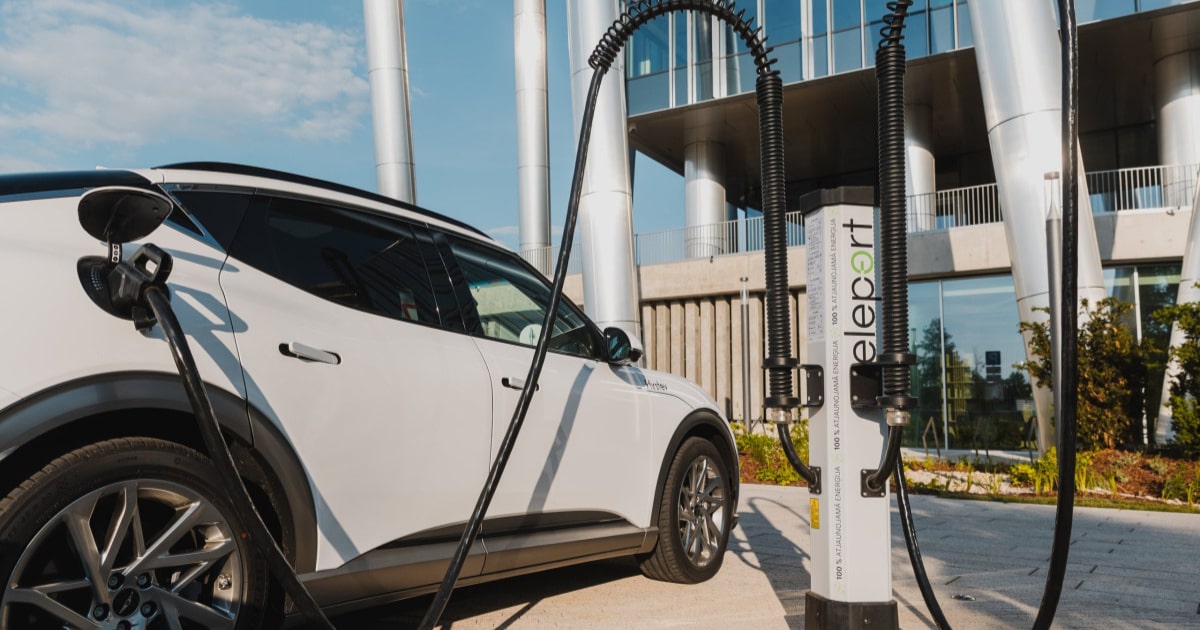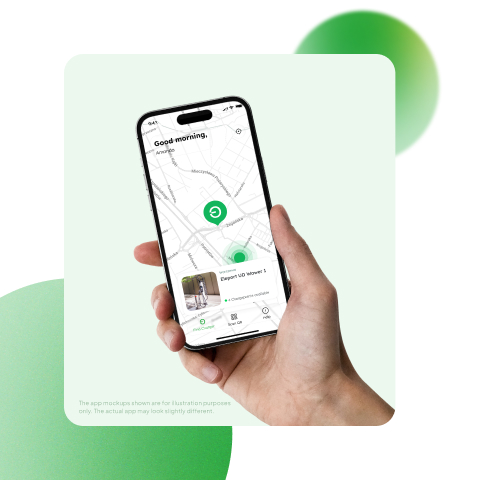In a decade, the act of refuelling a vehicle has begun to change profoundly, not just in form but in philosophy. The combustion engine, once the undisputed core of personal mobility, is gradually yielding to its quieter, cleaner successor. And with that shift comes a new infrastructure, regulation, and behaviour ecosystem. Central to it all is a deceptively simple question: how do EV charging stations work and what, exactly, is happening when EVs charge?
For a quick overview of how to charge and what to expect, start with Eleport’s EV charging guide. But read on if you’re curious about the systems behind the plug—how EV charging stations work and how companies like Eleport build smarter networks across Europe.
What Is EV Charging Station?
At its most basic level, an EV charging station, formally known as Electric Vehicle Supply Equipment (EVSE), is a system that transfers electrical energy from the grid to a vehicle’s battery. But the process is not just electrical, it’s also informational.

Modern charging stations are connected, communicative, and intelligent. They don’t just deliver current; they negotiate with the vehicle’s onboard systems. They identify the battery’s state of charge, temperature, and maximum accepted load. The charging session only starts if the safety checks between the vehicle and station allow for it. The chargers adjust delivery based on these parameters and, in many cases, take grid conditions into account, too.
This is what differentiates charging stations from passive infrastructure. They are part of a real-time energy ecosystem. Urban networks like those developed by Eleport are also part of the digital infrastructure, integrated into apps, payment systems, and data platforms that provide transparency, traceability, and control.
The Three Levels of Charging: AC at home and workplace, DC on the road
How do public EV charging stations work? Let’s talk about real-world use. If you’re an EV driver—or thinking about becoming one—you’ll run into three main types of chargers:
AC Home Charging – The “Slow and Steady” Option
A mobile charging cable comes with most EVs: a simple cable that plugs into your regular 230V wall socket and just works, as long as the socket is properly grounded.
Charging through this is what you would consider slow by looking at it, adding 11-18km of range to your EV per hour, as it is delivered at around 2.3 kW to 3.7 kW.
It is the easiest way of charging your EV if the car sits at home, and for example, you’re charging overnight. A ten-hour dwell time would give you 110km to 180km of extra range, far exceeding what most of us drive per day. Still, it is considered a mobile charger and usually not meant for everyday use at home.
The home electrical rates usually make home charging significantly cheaper than any public charging, especially when paired with the off-peak grid rates. Home charging is not for the occasions where you’ve got an empty battery but need to be across town in 30 minutes, but instead for everyday life.
AC Wall Charger, up to 22kW – The Everyday Workhorse

Most EV owners thus also decide to purchase a home wall charger, the name coming from the small pod-like charger being mostly installed on a wall, which can deliver mostly 11 kW but sometimes also 22 kW. That capability depends on the charger chosen, your home’s electrical system, and the onboard charger of your EV. Most EVs nowadays can take in 11 kW this way, rarely 22 kW.
While the home charger costs anywhere from 400€-1000€ or above, it is usually worth it as charging with 11kW already replenishes 100 kilometres of range in less than two hours. These chargers usually also come with the capabilities to follow the grid rates for optimal, cheaper charging.
These AC chargers, usually capable of charging with 22 kW, are often installed also in parking lots, offices, shopping centres, and, increasingly, residential buildings.
Eleport installs many of these in urban centres in the Baltic and Central Europe—places where people park for a few hours and want to leave with a full charge.
DC Fast Charging – When You’re On The Road
This is where things start to get powerful. DC fast chargers can add up to 300 kilometres of range in 20 to 30 minutes or even quicker. DC chargers skip the car’s onboard converter and send direct current straight into the battery.
DC Fast Charging is what you’ll find nearly exclusively in public charging sites dedicated to EV charging or added to common locations like shops. These use dedicated fast charging hardware that delivers from 50kW all the way to now-common 350kW, and are great for use when you’re in a hurry or roadtripping. These chargers can get your battery back to around 80% in less than half an hour. When you hit the road, you’ll find Eleport stations with 300kW or more all across the Baltic and Central Europe.
“The interesting part about switching to driving an EV is that in most cases, you’ll start spending less time refueling your car, not more. That is because most charging is done at home or at work, without being there with the car while it charges. This means that the time spent on charging really boils down to the 30 seconds or so it takes for you to plug your car and walk away. The same goes usually for fast charging stations, which are generally located near amenities like shops, parks, etc.
So the fact that an EV driver doesn’t need to go out of their way to visit a gas station and stand by the petrol pump until it’s finished means they often end up saving time compared to an ICE car instead,” said Jaan Juurikas, the founder of EVwire and a long-time EV owner.
How do EV Charging Stations Work: A Technical Overview

Despite the elegance of simply connecting a cable to a charging port, EV charging is a highly orchestrated data exchange to make sure the process is smooth and safe. Here’s step-by-step explanation:
Connection and Identification
The process begins when the electric car is physically connected to the charging station. Authentication occurs either automatically (via Plug&Charge) or through an app, RFID card, or contactless payment.
Digital Handshake
The charger and vehicle exchange information, including the current battery level, maximum acceptable voltage, thermal status, and target state of charge. This negotiation determines how power will be delivered and at what rate.
Power Transfer
If charging with an AC charger, the vehicle’s onboard converter manages the transformation of current. If charging in the direct current (DC) fast charger, the power is delivered directly to the battery pack. In both cases, the system continuously adjusts delivery based on battery temperature, ambient conditions, and energy availability. Not applicable on AC charging, but with DC charging you’ll notice your electric car reducing or increasing the charge speeds in real time, drawing out what people in the industry call a ‘charging curve’. These real-time adjustments are made possible through advanced technology built into the station and the battery-powered vehicle.
Monitoring and Completion
Charging continues until the user manually disconnects or the battery reaches its programmed limit. The system finalises the session, sends data to the user’s app or platform, and communicates with backend software for billing and reporting. This sequence, often completed in seconds, is where software plays as much of a role as hardware, ensuring battery efficiency, energy security, and seamless performance, even for drivers traveling across the country.
Power Sources: How Are EV Charging Stations Powered?
Most EV chargers are connected directly to the local grid, but they’re also increasingly being tied into broader energy strategies of cities or regions.
Modern stations like those operated by Eleport integrate renewable sources, including solar and wind, or source electricity with guarantees of origin (GOs) from green suppliers. Some sites even include stationary battery storage, which charges when energy is abundant (and cheap) and discharges during periods of high demand.
This model reduces emissions, increases grid stability, and supports the transition to a more distributed, resilient energy system.
Charging Is Made Simple: Apps, Payments, and Smart Tools
One of the biggest misconceptions about EV charging is that it’s complicated. But modern systems are doing a good job of making it seamless. In most cases, charging your electric car might actually be easier and quicker to handle than refueling a petrol car. With the Eleport app, for example, you can:
- Locate nearby stations
- Filter by charger type or speed
- See availability in real-time
- Start, stop, and pay for sessions from your phone
Beyond apps, many public chargers also accept contactless card payments, removing barriers for first-time users. The chargers are becoming smarter, too.
What Makes Smart Charging “Smart”?
This is where EV charging stations’ benefits start to show, especially at scale.
The added features of smart chargers include:
- Dynamic load balancing across multiple stations
- Scheduling charges when electricity is cheapest or cleanest
- Supporting renewable integration and grid stability
- Preparing for vehicle-to-grid applications
Platforms such as EV Connect help manage these systems, while companies like Eleport are integrating these capabilities into new infrastructure across Europe.
Public vs. Private Charging: Two Parts of the Same Puzzle
Not all EV charging happens in public spaces. In fact, a significant portion still occurs privately—at home or in the workplace—where drivers plug in overnight or during office hours. This means EV drivers can begin each day, or end their work day, with a fully charged vehicle. These private setups are convenient, cost-effective, and increasingly common for anyone with a driveway or a designated parking spot.
But public charging plays a fundamentally different and equally essential role. It fills in the structural gaps for people living in apartments, travelers moving across the country, or anyone whose day stretches beyond a typical commute. It makes the electric car viable for everyone, not just homeowners with garages.
Public infrastructure also acts as a safety net. Even if you charge at home most of the time, knowing a fast, reliable station nearby adds confidence and flexibility. That flexibility transforms EVs from practical city cars to full-scale replacements for traditional petrol vehicles.
How to Find EV Charging Stations
Finding a working charger in the early days of EVs felt like a treasure hunt. Today, it’s almost as simple as finding a coffee shop. Apps like PlugShare, Google Maps, and the Eleport app show real-time charger availability, speed, price, and user reviews. There are also several new tools available for planning longer EV trips, even those including several countries – we put together a comprehensive guide of EV route-planning tools. Many stations also allow remote start and payment so that you can manage the entire experience from your phone.
Final Thoughts
So, how do EV charging stations work? Technically, they just deliver electricity to an electric car. But in reality, they are part of something far more complex: a transformation in how we move, power our lives, and design systems for the 21st century.
Understanding how each system works and why it matters is essential. Charging is not just about energy delivered but also about access, equity, and long-term sustainability.



